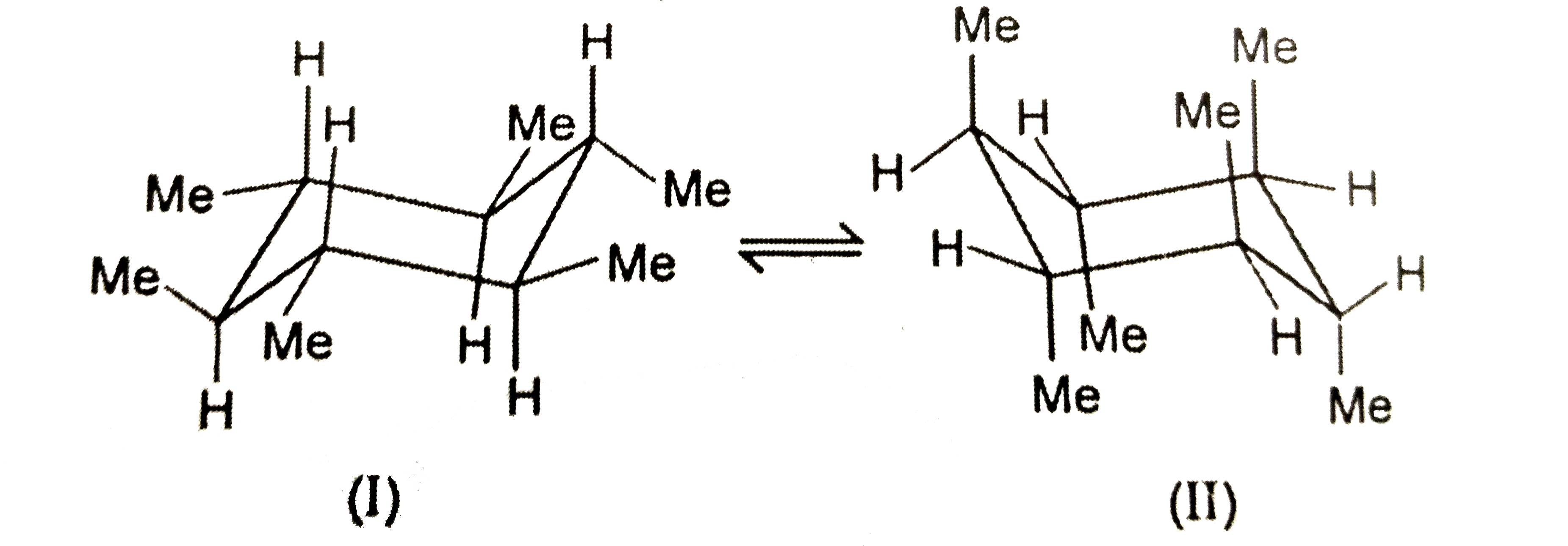In which of the following pairs of carbarion the first one is more stable than correct.
⊙CF3,⊙CCl3
HC≡ ⊙C,H2C=⊙CH

(CH3),⊙C,H3C−⊙CH2
The correct Answer is:B
To solve the question of which of the following pairs of carbanions has the first one being more stable, we will analyze each pair step by step.
Step 1: Analyze CF3- and CCl3-
- CF3- (Trifluoromethyl carbanion): The fluorine atoms are highly electronegative, which means they will attract electron density towards themselves. This results in a destabilization of the carbanion because the negative charge is less stable when surrounded by highly electronegative atoms.
- CCl3- (Trichloromethyl carbanion): Chlorine is less electronegative than fluorine, so it will not pull electron density as strongly. Additionally, chlorine has a larger atomic size, allowing for better accommodation of the negative charge in its larger orbitals.
Conclusion: CCl3- is more stable than CF3-. Therefore, the first one (CF3-) is not more stable than the second one (CCl3-).
Step 2: Analyze CH≡C- and CH2=CH-
- CH≡C- (Acetylide carbanion): This carbanion has sp hybridization, which means it has 50% s character. Higher s character means the electrons are held closer to the nucleus, making the negative charge more stable.
- CH2=CH- (Vinyl carbanion): This carbanion has sp2 hybridization, which means it has 33.33% s character. The electrons are not held as tightly as in the sp hybridized carbanion.
Conclusion: CH≡C- is more stable than CH2=CH-. Therefore, the first one (CH≡C-) is more stable than the second one (CH2=CH-).
Step 3: Analyze Cyclohexyl- and Benzyl-
- Cyclohexyl-: This carbanion is sp3 hybridized and has a certain stability due to its saturated structure.
- Benzyl-: This carbanion is sp2 hybridized and is stabilized by resonance due to the adjacent aromatic ring.
Conclusion: Benzyl- is more stable than Cyclohexyl-. Therefore, the first one (Cyclohexyl-) is not more stable than the second one (Benzyl-).
Step 4: Analyze Tertiary alkyl- and Primary alkyl-
- Tertiary alkyl- (e.g., (CH3)3C-): This carbanion is stabilized by hyperconjugation and inductive effects from the three alkyl groups.
- Primary alkyl- (e.g., CH3CH2-): This carbanion has only one alkyl group providing stabilization.
Conclusion: Tertiary alkyl- is more stable than Primary alkyl-. Therefore, the first one (Tertiary alkyl-) is more stable than the second one (Primary alkyl-).
Final Conclusion:
From the analysis above, the only pair where the first carbanion is more stable than the second is the pair involving tertiary and primary alkyl carbanions.
- CF3- (Trifluoromethyl carbanion): The fluorine atoms are highly electronegative, which means they will attract electron density towards themselves. This results in a destabilization of the carbanion because the negative charge is less stable when surrounded by highly electronegative atoms.
- CCl3- (Trichloromethyl carbanion): Chlorine is less electronegative than fluorine, so it will not pull electron density as strongly. Additionally, chlorine has a larger atomic size, allowing for better accommodation of the negative charge in its larger orbitals.
- CH≡C- (Acetylide carbanion): This carbanion has sp hybridization, which means it has 50% s character. Higher s character means the electrons are held closer to the nucleus, making the negative charge more stable.
- CH2=CH- (Vinyl carbanion): This carbanion has sp2 hybridization, which means it has 33.33% s character. The electrons are not held as tightly as in the sp hybridized carbanion.
- Cyclohexyl-: This carbanion is sp3 hybridized and has a certain stability due to its saturated structure.
- Benzyl-: This carbanion is sp2 hybridized and is stabilized by resonance due to the adjacent aromatic ring.
- Tertiary alkyl- (e.g., (CH3)3C-): This carbanion is stabilized by hyperconjugation and inductive effects from the three alkyl groups.
- Primary alkyl- (e.g., CH3CH2-): This carbanion has only one alkyl group providing stabilization.
From the analysis above, the only pair where the first carbanion is more stable than the second is the pair involving tertiary and primary alkyl carbanions.
Topper's Solved these Questions
- GENERAL ORGANIC CHEMISTRY IIBOOK - RESONANCE ENGLISHCHAPTER - GENERAL ORGANIC CHEMISTRY IIEXERCISE - Part-III: Match the Column
2 Videos
- GENERAL ORGANIC CHEMISTRY IIBOOK - RESONANCE ENGLISHCHAPTER - GENERAL ORGANIC CHEMISTRY IIEXERCISE - Part-I : Only One Option Correct Type
22 Videos
- GENERAL ORGANIC CHEMISTRY IIBOOK - RESONANCE ENGLISHCHAPTER - GENERAL ORGANIC CHEMISTRY IIEXERCISE - Exercise-1
20 Videos
- GASEOUS STATEBOOK - RESONANCE ENGLISHCHAPTER - GASEOUS STATEEXERCISE - ORGANIC CHEMISTRY(Hydrocarbon)
18 Videos
- GENERAL ORGANIC CHEMISTRY-IBOOK - RESONANCE ENGLISHCHAPTER - GENERAL ORGANIC CHEMISTRY-IEXERCISE - PART-III : PRACTICE TEST-19
1 Videos
Similar Questions
Knowledge Check
In which of following pairs the first one is the stronger base than second?
ACH3COOө,HCOOөBөH,өOH,өNH2CCH2=CөH,HC≡өCDCH3NH2,CH3OH
In which of the following elements +3 oxidation state is more stable than +5?
View SolutionWhich one is more stable and why?

View SolutionIn which of the following pairs first partner is more soluble in water than second partner ?
View SolutionWhich of the following pairs of compounds are more stable?
View SolutionIn which of the following pairs the bromination of first member is easier than the second member ?
View SolutionWhich one of the following is most stable
View SolutionIn which one of the following pairs the radius of the second species is greater than that of first ?
View Solution
